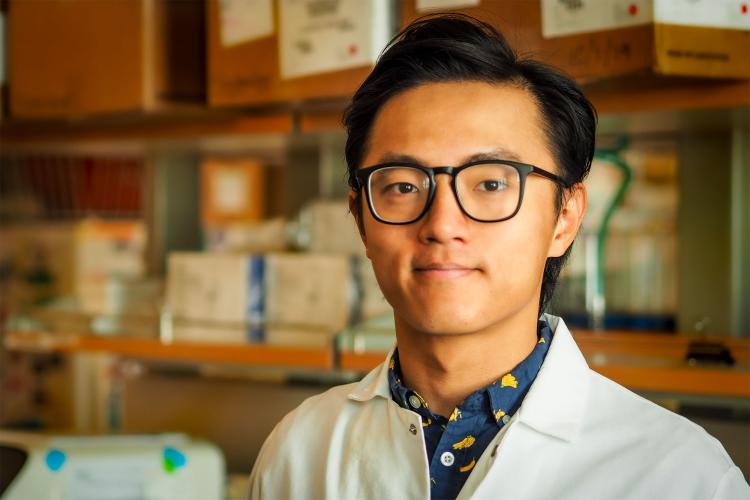As pandemic spread, ‘I couldn’t just sit around’
After getting stuck in China, graduating PhD student pivoted research to help test for the COVID-19 virus without nasal swab
Stranded for the first two months of the COVID-19 pandemic at his family home in China, virus specialist Qing Yang was inspired to change his research direction, helping to create one of that pathogen’s first saliva tests.
The test was first deployed at the University of Colorado Boulder and around Colorado starting in the late summer of 2020 before being used elsewhere in the United States and Brazil.
Using data from the test, Yang and a research team published findings about asymptomatic COVID-19 in May 2021, concluding that a small number of individuals spread the disease.
Traveling to help fight COVID-19
Yang’s journey back to CU Boulder in spring 2020 was delayed when the U.S. Embassy in China closed in response to the burgeoning pandemic. Sara Sawyer, one of his advisors and a professor of molecular, cellular and developmental biology, helped brainstorm a route back to Boulder, verifying in a letter to the U.S. Embassy that he was needed for important COVID research.

At the top of the page: Qing Yang examines samples of the rapid COVID-19 saliva test in the Sawyer Lab (Glenn Asakawa/CU Boulder). Above: Qing Yang is a graduating PhD student in molecular biology.
“I realized that working in such a related area, I couldn’t sit around,” said Yang, a graduating PhD candidate in molecular biology.
While in China, he used computational skills learned in his undergraduate studies to look at the dynamics of viral transmission and how more frequent testing could prevent the spread of the virus, he said.
In March 2020 he was able to exit to Thailand—staying there two weeks to get around travel limits from China during the early pandemic—and re-enter the United States in April 2020, after a brief stop in Canada.
Creating an important test
Back in Boulder, Yang and others in Sawyer’s research lab at the BioFrontiers Institute began looking at ways to reconfigure an existing rapid test method—previously used to diagnose dengue and other infection—to work without nasal swabs.
They created a test that uses saliva to produce answers in 45 minutes. Using very few materials, only pipettes (slender tubes for transferring liquid) and a heating source, their test was considered community deployable.
After CU Boulder asked them to prepare the test for locations on campus, the team ran hundreds of samples to vet their system. Learning that test accuracy dropped when they scaled the testing, they spent several nights figuring out where the process went wrong and realized samples weren’t sealed well and evaporation was rendering results less accurate. Adding appendices to their paper, they showed how to troubleshoot step by step for accurate readouts.
Then the team worked to source materials for the test—a challenge during the early pandemic supply-chain slowdown—and deployed it on the CU Boulder campus and elsewhere.
Yang and his colleagues published their findings about their test as well as the necessity for frequent testing.
Before the pandemic, Yang’s graduate work focused on finding host signatures (signs that a cell has been occupied by a pathogen) that signify an ongoing infection. This research was part of a project to find treatments for certain viruses. When the COVID pandemic started, he paused those investigations but has since returned to them.
In March 2020, he and a few colleagues co-founded the company Darwin Biosciences, which licenses the techniques in their test. With Darwin, they’re currently developing a handheld device that will detect host signatures in a saliva sample instead of pathogens, using the signatures as an indication of infection.
Previous viral research
As an undergraduate studying computer science and microbiology, Yang read the book The Hot Zone, about the origins of Ebola.
In the case of COVID response, everything accelerated; you immediately saw the outcome of your research being put into effect. That’s exciting.”
“I was fascinated by how researchers jump into these scenarios,” Yang said about why he chose to study viruses in graduate work.
He’s also intrigued by “how simple viruses are—and at the same time they can cause such traumatic consequences in public health and trigger such diverse human symptoms.”
Interested in understanding more, he planned to use his two areas of study, computer science and biology, to mine data and conduct original research.
“Knowing that CU’s BioFrontiers Institute focuses on this type of collaboration, computation with biology, is part of why I chose Boulder for my graduate work,” said Yang.
After his CU graduation, Yang will work as a postdoctoral fellow at Fred Hutchison Cancer Center in Seattle, using computational research to determine how hosts respond to their first encounter with a virus. The work will involve collaboration with labs and museums in Mexico to look at the virus genetic sequences from archeological remains. In part, they’ll try to learn how past colonialism in Central America affects the distribution of viruses within the population and the disease outbreaks that have happened to Indigenous people.
Having his own opportunity to find solutions during a pandemic made him see the ways laboratory and computational research can be put into practice in the real world, said Yang.
“In the case of COVID response, everything accelerated; you immediately saw the outcome of your research being put into effect. That’s exciting. So is the fact that so many people stepped up and learned so many aspects of this virus.”

